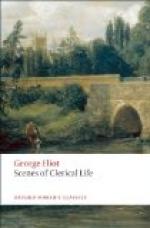By-and-by the happy monotony of Cheverel Manor was broken in upon in the way Mr. Warren had announced. The roads through the park were cut up by waggons carrying loads of stone from a neighbouring quarry, the green courtyard became dusty with lime, and the peaceful house rang with the sound of tools. For the next ten years Sir Christopher was occupied with the architectural metamorphosis of his old family mansion; thus anticipating, through the prompting of his individual taste, that general reaction from the insipid imitation of the Palladian style, towards a restoration of the Gothic, which marked the close of the eighteenth century. This was the object he had set his heart on, with a singleness of determination which was regarded with not a little contempt by his fox-hunting neighbours, who wondered greatly that a man with some of the best blood in England in his veins, should be mean enough to economize in his cellar, and reduce his stud to two old coach-horses and a hack, for the sake of riding a hobby, and playing the architect. Their wives did not see so much to blame in the matter of the cellar and stables, but they were eloquent in pity for poor Lady Cheverel, who had to live in no more than three rooms at once, and who must be distracted with noises, and have her constitution undermined by unhealthy smells. It was as bad as having a husband with an asthma. Why did not Sir Christopher take a house for her at Bath, or, at least, if he must spend his time in overlooking workmen, somewhere in the neighbourhood of the Manor? This pity was quite gratuitous, as the most plentiful pity always is; for though Lady Cheverel did not share her husband’s architectural enthusiasm, she had too rigorous a view of a wife’s duties, and too profound a deference for Sir Christopher, to regard




